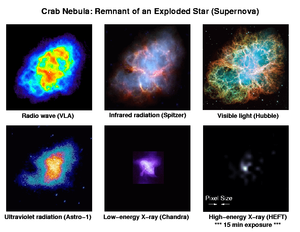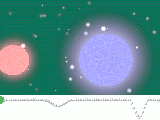Portal:Radiation astronomy

Radiation astronomy is astronomy applied to the various extraterrestrial sources of radiation, especially at night. It is also conducted above the Earth's atmosphere and at locations away from the Earth, by satellites and space probes, as a part of explorational (or exploratory) radiation astronomy.
Seeing the Sun and feeling the warmth of its rays is probably a student's first encounter with an astronomical radiation source. This will happen from a very early age, but a first understanding of the concepts of radiation may occur at a secondary educational level.
Radiation is all around us on top of the Earth's crust, regolith, and soil, where we live. The study of radiation, including radiation astronomy, usually intensifies at the university undergraduate level.
And, generally, radiation becomes hazardous, when a student embarks on graduate study.
Cautionary speculation may be introduced unexpectedly to stimulate the imagination and open a small crack in a few doors that may appear closed at present. As such, this learning resource incorporates some state-of-the-art results from the scholarly literature.
The laboratories of radiation astronomy are limited to the radiation observatories themselves and the computers and other instruments (sometimes off site) used to analyze the results.
Radiation astronomy objects

Def. a hemispherical pit a basinlike opening or mouth about which a cone is often built up any large roughly circular depression or hole is called a crater.
The image at right shows a chain of 13 craters (Enki Catena) on Ganymede measuring 161.3 km in length. "The Enki craters formed across the sharp boundary between areas of bright terrain and dark terrain, delimited by a thin trough running diagonally across the center of this image. The ejecta deposit surrounding the craters appears very bright on the bright terrain. Even though all the craters formed nearly simultaneously, it is difficult to discern any ejecta deposit on the dark terrain.
Theoretical radiation astronomy

At its simplest theoretical radiation astronomy is the definition of terms to be applied to astronomical radiation phenomena.
Def. a theory of the science of the biological, chemical, physical, and logical laws (or principles) with respect to any natural radiation source in the sky especially at night is called theoretical radiation astronomy.
Exploratory theory is the playtime activity that leads to discoveries which better our world. In the radiation physics laboratories here on Earth, the emission, reflection, transmission, absorption, and fluorescence of radiation is studied and laws relative to sources are proven.
A principle is a law or rule that has to be, or usually is to be followed, or can be desirably followed, or is an inevitable consequence of something, such as the laws observed in nature or the way that a system is constructed. The principles of such a system are understood by its users as the essential characteristics of the system, or reflecting system's designed purpose, and the effective operation or use of which would be impossible if any one of the principles was to be ignored.[1]
Radiation astronomy consists of three fundamental parts:
- derivation of logical laws with respect to incoming radiation,
- natural radiation sources outside the Earth, and
- the sky and associated realms with respect to radiation.
Def. a spontaneous emission of an α ray, β ray, or γ ray by the disintegration of an atomic nucleus is called radioactivity.[2]
References
- ↑ Guido Alpa (1994). "General Principles of Law". Annual Survey of International & Comparative Law 1: 1. http://heinonlinebackup.com/hol-cgi-bin/get_pdf.cgi?handle=hein.journals/ansurintcl1§ion=4. Retrieved 2012-04-29.
- ↑ Philip B. Gove, ed (1963). Webster's Seventh New Collegiate Dictionary. Springfield, Massachusetts: G. & C. Merriam Company. pp. 1221.
Emissions

"[T]he extended red emission (ERE) [is] observed in many dusty astronomical environments, in particular, the diffuse interstellar medium of the Galaxy. ... silicon nanoparticles provide the best match to the spectrum and the efficiency requirement of the ERE."[1]
References
- ↑ Adolf N. Witt, Karl D. Gordon and Douglas G. Furton (July 1, 1998). "Silicon Nanoparticles: Source of Extended Red Emission?". The Astrophysical Journal Letters 501 (1): L111-5. doi:10.1086/311453. http://iopscience.iop.org/1538-4357/501/1/L111. Retrieved 2013-07-30.

SN 185 was a supernova which appeared in the year 185, near the direction of Alpha Centauri, between the constellations Circinus and Centaurus, centered at Right ascension (RA) 14h 43m Declination (Dec) -62° 30', in Circinus. This "guest star" was observed by Chinese astronomers in the Book of Later Han.
On the right is a "combined image from the Chandra and XMM-Newton X-ray observatories of RCW 86 [in the constellation Circinus showing] the expanding ring of debris that was created after a massive star in the Milky Way collapsed onto itself and exploded. Both the Chandra and XMM images show low energy X-rays in red, medium energies in green and high energies in blue. The Chandra observations focused on the northeast (left-hand) side of RCW 86, and show that X-ray radiation is produced both by high-energy electrons accelerated in a magnetic field (blue) as well as heat from the blast itself (red)."[1]
"Properties of the shell in the Chandra image, along with the remnant's size and a basic understanding of how supernovas expand, were used to help determine the age of RCW 86. The new data revealed that RCW 86 was created by a star that exploded about 2,000 years ago. This age matches observations of a new bright star by Chinese astronomers in 185 A.D. (and possibly Romans as well) and may be the oldest known recordings of a supernova. Supernova explosions in galaxies like ours are rare, and none have been recorded in hundreds of years."[1]

This seven-million-cubic-foot super-pressure balloon is the largest single-cell, super-pressure, fully-sealed balloon ever flown. Credit: NASA.{{free media}}
First violet source in Leo

The first violet source in Leo is unknown.
The field of violet astronomy is the result of observations and theories about violet sources detected in the sky above.
The first astronomical violet source discovered may have been the Sun.
But, violet waves from the Sun are intermingled with other radiation so that the Sun may appear as other than a primary source for violet waves.
The early use of sounding rockets and balloons to carry violet detectors high enough may have detected violet waves from the Sun as early as the 1940s.
This is a lesson in map reading, coordinate matching, and searching. It is also a project in the history of violet astronomy looking for the first astronomical violet source discovered in the constellation of Leo.
Nearly all the background you need to participate and learn by doing you've probably already been introduced to at a secondary level and perhaps even a primary education level.
Some of the material and information is at the college or university level, and as you progress in finding violet sources, you'll run into concepts and experimental tests that are an actual search.
Empirical radiation astronomy quiz

Empirical radiation astronomy is a lecture about an approach to understanding radiation astronomy phenomena. It is an adjunct lecture for the radiation astronomy department course on the principles of radiation astronomy.
You are free to take this quiz based on empirical radiation astronomy at any time.
To improve your score, read and study the lecture, the links contained within, listed under See also, External links, and in the {{radiation astronomy resources}} template. This should give you adequate background to get 100 %.
As a "learning by doing" resource, this quiz helps you to assess your knowledge and understanding of the information, and it is a quiz you may take over and over as a learning resource to improve your knowledge, understanding, test-taking skills, and your score.
Suggestion: Have the lecture available in a separate window.
To master the information and use only your memory while taking the quiz, try rewriting the information from more familiar points of view, or be creative with association.
Enjoy learning by doing!
Electron beam heating laboratory

This laboratory is an activity for you to create a method of heating the solar corona or that of a star of your choice. While it is part of the astronomy course principles of radiation astronomy, it is also independent.
Some suggested entities to consider are electromagnetic radiation, electrons, positrons, neutrinos, gravity, time, Euclidean space, Non-Euclidean space, magnetic reconnection, or spacetime.
More importantly, there are your entities.
Please define your entities or use available definitions.
Usually, research follows someone else's ideas of how to do something. But, in this laboratory you can create these too.
Okay, this is an astronomy coronal heating laboratory.
Yes, this laboratory is structured.
I will provide an example of electron beam heating calculations. The rest is up to you.
Please put any questions you may have, and your laboratory results, you'd like evaluated, on the laboratory's discussion page.
Enjoy learning by doing!
Column densities

A column density is the number of units of matter observed along a line of sight that has an area of observation. This area has a height that is the distance to an object, or through which observation is taking place.
"A region of the sky [at right] called the "Lockman Hole", located in the constellation of Ursa Major, is one of the areas surveyed in infrared light by the Herschel Space Observatory. All of the little dots in this picture are distant galaxies. The pattern of their collective light is what's known as the cosmic infrared background. By studying this pattern, astronomers were able to measure how much dark matter it takes to create a galaxy bursting with young stars."[2]
References
- ↑ 1.0 1.1 J. Vink (15 June 2004). RCW 86: New Evidence Links Stellar Remains to Oldest Recorded Supernova. Cambridge, Massachusetts, USA: Harvard-Smithsonian Center for Astrophysics. http://chandra.harvard.edu/photo/2006/rcw86/. Retrieved 2016-02-12.
- ↑ Jamie Bock (February 16, 2011). Herschel's View of 'Lockman Hole'. Pasadena, California USA: Caltech. http://www.herschel.caltech.edu/image/nhsc2011-003a. Retrieved 2014-03-15.

Using the orbiting Chandra X-ray telescope, astronomers have imaged the center of our near-twin island universe, finding evidence for a bizarre object. Like the Milky Way, Andromeda's galactic center appears to harbor an X-ray source characteristic of a black hole of a million or more solar masses. Seen above, the false-color X-ray picture shows a number of X-ray sources, likely X-ray binary stars, within Andromeda's central region as yellowish dots. The blue source located right at the galaxy's center is coincident with the position of the suspected massive black hole. While the X-rays are produced as material falls into the black hole and heats up, estimates from the X-ray data show Andromeda's central source to be very cold - only about million degrees, compared to the tens of millions of degrees indicated for Andromeda's X-ray binaries.
Fields associated with radiation astronomy include Astronomy, Astrogeology, Astrognosy, Astrohistory, Astrophysics, Atmospheric sciences, Charge ontology, Chemistry, Cosmogony, Fringe sciences, Geochemistry, Geochronology, Geology, Geomorphology, Geophysics, Geoseismology, Hydromorphology, Lofting technology, Mathematics, Measurements, Mining geology, Nuclear physics, Oceanography, Petrophysics, Radiation physics, Shielding, Spaceflights, Structural geology, Technology, Trigonometric-parallax astronomy, and X-ray trigonometric parallax
Other Wikiversity science-related portals: Anthropology - Archaeology - Astronomy - Biology - Biochemistry - Chemistry - Ecology - Fluid mechanics - Genetics - Hematology - Immunology - Life sciences - Materials science and engineering - Neurology - Organic chemistry - Particle physics - Quantum biology - Regional anatomy - Sciences - Technology
|
Wikiversity's sister projects
Wikiversity is hosted by the Wikimedia Foundation, a non-profit organization that also hosts a range of other multilingual and free-content projects: Wikipedia
Free-content encyclopedia Wikibooks
Free textbooks and manuals Commons
Shared media repository Incubator
Wikimedia incubator Wiktionary
Dictionary and thesaurus Wikiquote
Collection of quotations Wikinews
Free-content news Betawikiversity
Betawikiversity project Wikispecies
Directory of species Wikisource
Free-content library Wikivoyage
Open travel guide Phabricator
MediaWiki bug tracker Meta-Wiki
Wikimedia project coordination MediaWiki
Free software development Wikidata
Free knowledge base Wikimedia Labs
MediaWiki development Wikiversity is also available in other languages: |
Content by Subject
Arts ·
Humanities ·
Mathematics ·
Medicine ·
Science ·
Social Sciences ·
Technology
Content by Level
Pre-school Education ·
Primary Education ·
Secondary Education ·
Tertiary Education ·
Non-formal Education ·
Research















